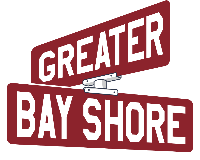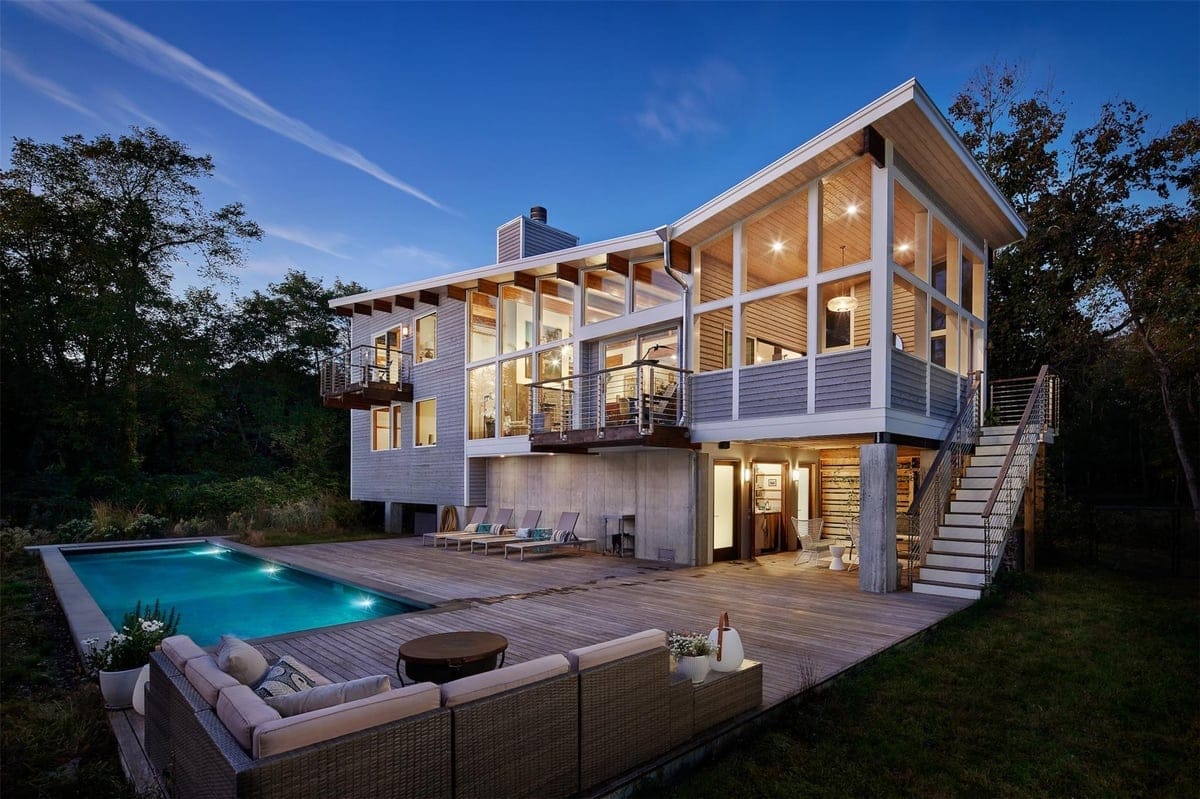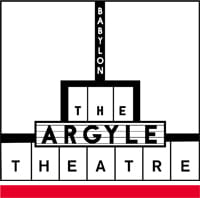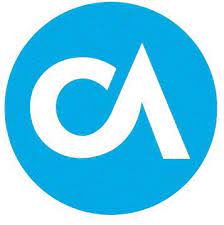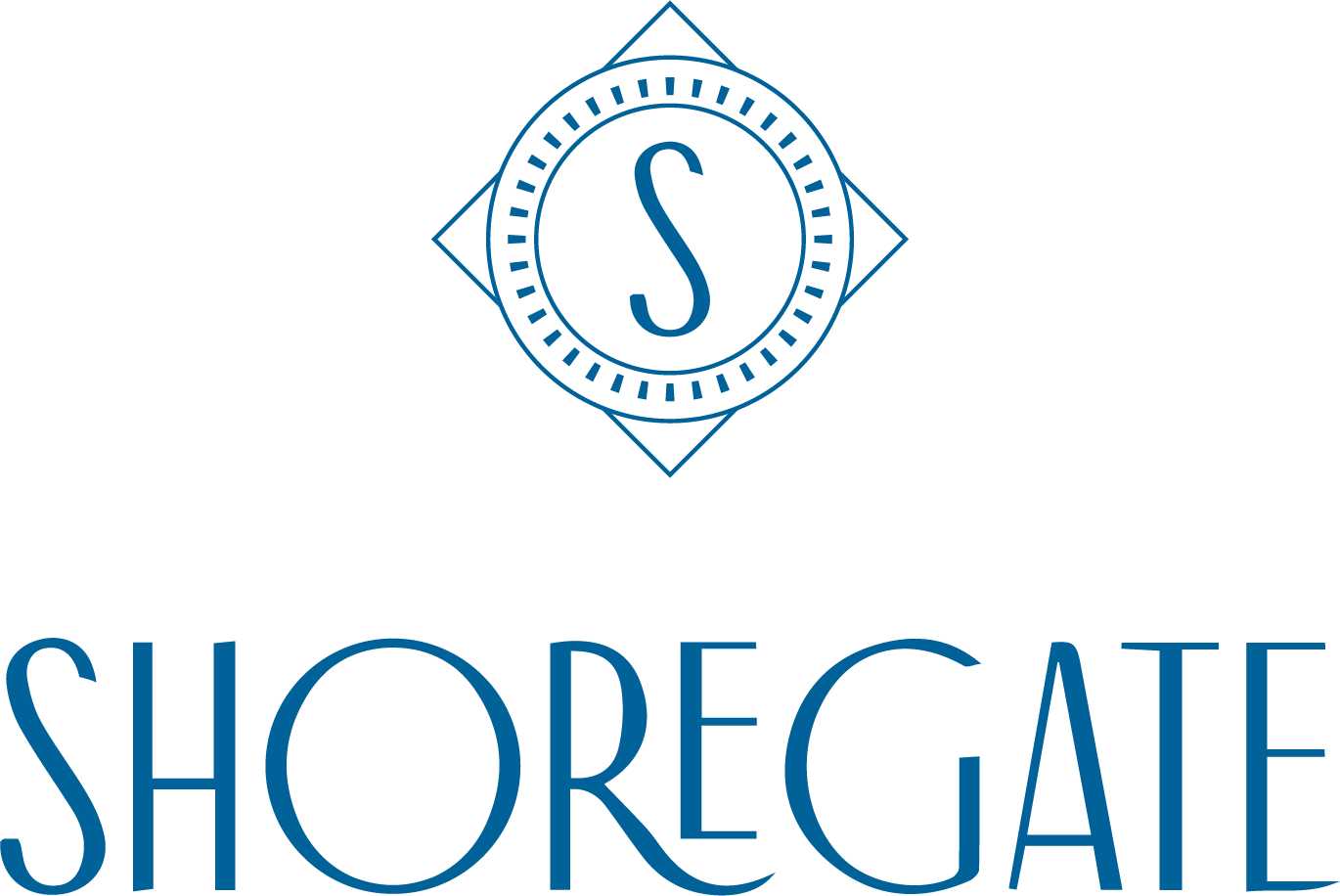
OUR SPONSOR
Greater Bay Shore coverage is funded in part by Shoregate, now leasing brand-new premium apartment homes in the heart of Bay Shore. Click here to schedule a tour.
At a standing-room-only Bay Shore Chamber of Commerce meeting Tuesday night, Tritec — the developer of a proposed mixed-use rental apartment complex planned for the former Touro college property — faced an antagonistic audience as the company presented its plans for the project.
The biggest point of contention was how many school-aged children the apartments would actually bring into the Bay Shore School District.
On the one side, Tritec presented its evidence that that number would be between 12 to 41, using the methodologies of two recent Long Island studies — as well as figures from prior apartment projects.
The developers also predicted their tax contributions would result in a net positive for the district, as they say happened in Patchogue, where Tritec built a $110 million, 291-unit complex called New Village at Patchogue, which opened in 2014.
On the other hand, school district administrators, teachers, and parents contended that Tritec’s projections are erroneous and that number will be much higher, resulting in a financial burden on the district with no recourse to raise additional funds to cover the shortfall in their budget due to the New York State school tax cap.
Their argument is that unlike other communities where Tritec says their projects resulted in a minimal influx of additional students, people come to Bay Shore specifically because of the superiority of the schools, and that the project will attract too many new families with school-aged children.
Underlying issues also included the economic impact of the project, traffic and parking concerns, and the changing landscape of Bay Shore, especially with what is possibly the largest multi-unit development project to come to the hamlet in recent memory.
Comparisons
“Touro was one of the best friends Bay Shore ever had,” Donna Periconi, president of the Chamber of Commerce, announced to the almost 200 residents, educators, and other interested parties at the Bay Shore-Brightwaters Public Library that night when she opened the discussion about the new project. “They came to Bay Shore when no one ever would.”
Before Tritec there were other ideas of what could be done with the property.
“What we’d like to have is a botanical garden,” Periconi said of her initial idea before Tritec came in with their plans for an apartment complex. That was in 2018.
She said Tritec did their homework before coming to Bay Shore, and the project they undertook in Patchogue had a hand in turning that village around.
In Patchogue, Tritec’s 291-unit New Village project currently sends 12 students to the Patchogue-Medford School District, Tritec representatives said this week.
According to Patchogue Mayor Paul Pontieri, from all the residential multi-family units built in the village between 2006 and 2017 — seven projects in total, including Tritec’s — there were 40 enrolled students from 663 housing units as of Dec. 14, 2018, the last time the numbers were updated. Those units include both affordable and at-market rentals, as well as condos/townhouses.
A Long Island Planning Council economic impact study that was unveiled in December estimated a total of 142 new students to the Patchogue-Medford District over the 11-year time period.
“Our analysis suggests that the seven multi-family residential projects examined accounted for, at most, 142 PSAC (90 elementary, 28 junior high and 24 high school students) since 2006” reads the study, which was unveiled in December.
What the village also found, Pontieri said, was that from 2006 to 2017, the school district recorded about $6.61 million in estimated tax levies from the developed properties, with $1.18 million in added educational costs.
That’s good for about a $5.43 million in estimated surplus.
And, “this surplus revenue will increase substantially as the Industrial Development Agency [IDA] tax abatement given to New Village decreases,” Pontieri had said.
Back to Bay Shore
The investment Tritec expects to make in Bay Shore is in the order of $180 million, according to Periconi.
She urged audience members Tuesday night to hear the developer out.
“Before everyone says no,” she added.
Calling the train station a “disgrace” and Union Boulevard a “tremendous problem,” she said Tritec is presenting an opportunity to bring in a “tremendous development.”
Then the builder presented its case.
The mixed-use building will be constructed on the 10.3-acre site of the former Touro college campus. It will consist of 456 rental units and a 5,000 square-foot commercial portion that the developer said will mostly likely be one single unit. The apartments will be made up of 64 studios, 243 one-bedroom, 127 two-bedroom, and 22 three-bedroom units.
These are market-rate apartments. Tritec did not have specific numbers for monthly rent but put it at about $2,400 on average.
Amenities inside the building include a fitness and aerobics center, clubrooms and lounges, dog wash station, gaming room, a co-working space and elevators.
The building will also feature a swimming pool, barbecue stations, fire pit, car charging stations, bike repair station, and covered at-grade open air parking. The building will have on-site management with secured building access.
The developer said it took inspiration for the architecture of the building from historical hotels in the area and combined that with a nautical theme. The exterior will be Hardie board to make it durable and resistant to erosion from salt air and preserve the coloring so it doesn’t fade.
During the meeting, some questioned how close the multi-story building will be from the street, saying it looked very close in renderings. According to Tritec’s proposal, there is a 20- to 25-foot setback from the curb, with a buffer.
Also at issue was stormwater runoff to the bay. When asked about water drainage, the developer said it addressed the matter, ensuring that runoff would be held to the site. The building would also be connected to the Southwest Sewer District.
Economic impact
In his presentation, Robert Coughlan, one of Tritec’s principals, positioned Tritec as a developer that is concerned with constructing projects that solve one of the largest issues facing Long Island today, what has been called brain drain or the flight of young people from the Island due to lack of transit-oriented housing that appeals to their desire for a walkable community experience close to mass transit.
Coughlan pointed to the company’s New Village at Patchogue project, The Shipyard in downtown Port Jefferson, and the Ronkonkoma Hub.
He cited studies that showed the demand for multi-family housing increasing and that Long Island has 50 percent of the supply of this type of housing compared to the national average.
“We are losing many young people,” he said. “And our seniors.”
While demographics have changed, the housing stock has remained stagnant, according to Coughlan.
A comparison of 1970 demographics to 2017 numbers from the Long Island Index Census Tract showed that 49 years ago, about 13 percent of households in Bay Shore were single-person households.
Now, that number is around 58 percent. Married couples with children made up 32 percent of households. Today that number has sunk to 23 percent. Single parent households grew from less than 1 percent to over 15 percent.
He also said the residents of buildings like the one Tritec proposes for Bay Shore invest in their communities.
“We feel this will spur economic development,” Coughlan said.
Susan Barbash, a Bay Shore resident who also runs a family business that developed similar multi-family projects, called herself a “veteran of the Bay Shore redevelopment story” when she stood up to speak at the meeting.
While understanding the developer’s plans to further the revitalization of the town, she also urged caution and an open dialogue.
“There is a sense here that we are becoming a victim of our own success,” Barbash said. “People are feeling things are getting a little bit out of control. I urge you to listen.”
Directly tied to economic impact was crime, a major concern for residents.
Coughlan said that similarly during construction in Patchogue there was crime in the immediate area and they saw the positive effects their project had.
Investment in Bay Shore around the project and continued revitalization will decrease the level of crime as property values go up — and pedestrian traffic increases.
When you “light those dark shadows crime tends to go away,” he said.
Not everyone in the audience Tuesday thought Tritec had everything figured out, and saw flaws in their comparisons to previous projects, especially to New Village in Patchogue.
They admitted that Patchogue’s revitalization was admirable, but said Bay Shore was no Patchogue and their streets and school district presented very different challenges — like comparing apples to oranges.
Traffic and parking
“Your studies are highly flawed,” said one unamed resident commenting on Tritec’s traffic estimates. “You are not taking into account the actual traffic here.”
At issue was the studies they used and the hours the developer defined as peak traffic times.
The developer said it looked at 10 different intersections around the property and used cameras and their own analysis to count traffic to calculate peak hours at each individual intersection.
They did not say which specific intersections they studied.
Another resident, who also did not identify himself, pointed out that Patchogue attracts far less Fire Island ferry traffic than Bay Shore does.
He also said train station traffic causes serious delays with a half mile trip taking 6 to 7 minutes by car in the area. He wanted a comparison to a town that was more like Bay Shore, and to look at traffic in the hamlet during popular times in the summer from July to August and on Labor Day.
The comment prompted loud applause from the room.
In a traffic analysis, the developer said they studied traffic in May and July. They also designed a court on the property to have drop-offs taken off the road — and onto the premises itself — helping to alleviate the flow of traffic to the building.
Tritec will allow for 1.5 parking spaces per unit and said almost 50 percent of needed parking will be within the complex.
An engineer for the developer said that the number of parking spaces allowed was more than adequate to accommodate the development and take into account visitors.
The school district
“People come here for the schools.”
It was a common refrain among speakers saying the number of students estimated to be added to the district would likely be much higher than Tritec’s projections.
It was the debate that caused the most controversy and concern for residents. With questions from how the builder came up with their estimates to how the school would pay for the additional students.
Tritec said they used two different studies and their previous experience with multi-family development projects to come up with their estimates.
Based on a Vision LI study they used, the company predicted 12 school-aged children added to the Bay Shore district.
A Real Estate Institute at Stony Brook study brought the estimate higher, at 41 students. In both cases, this represented an increase of less than 1 percent of total enrollment in the Bay Shore School District (0.2% to 0.69%), according to the builder.
Both studies were based on Long Island numbers, which were different than previous methodologies, which were not local.
They also used the highest enrollment years for the time period covered in each study to be conservative with estimates.
Coughlan said that taxes on the property will contribute $1 million to the school district, and that will more than cover the expense of education for the additional students.
“You will be tax positive,” he said.
Christopher Venator, an attorney with Ingerman Smith, a law firm that represents the district, spoke on behalf of the school. Venator said there were many concerns raised that Tritec did not address.
He said there is the potential for the schools to be forced to absorb an unlimited number of students, putting a strain on the district.
Because of the structure of Payment In Lieu of Taxes (PILOT) payments the builder would likely pay on the property — should they get approved for Industrial Development Agency tax benefits — the district would be hamstrung from being able to raise the funds needed to educate the influx of students from the development.
Combined with the New York State tax cap, school boards are limited in their abilities as a district to raise budgets to accommodate for new children.
“PILOTs are not going to increase available revenue for the Bay Shore School District,” Venator said. “It’s not going to help you pay for additional students.”
He explained that the tax cap law requires PILOT payments be excluded from its formula. He called it a fallacy that projected PILOT payments will result in increased revenue going to the school district budget.
“This project is not going to provide additional revenue to the Bay Shore School District,” Venator said. “As goes the school district, so goes the community.”
“We are not willing to accept what is essentially a roll of the dice.”
Venator elicited a standing ovation of support by a large portion of the audience after he spoke.
Tritec representatives acknowledged that the tax cap question was an important one, but stood by their estimates. Currently, the property is not on the tax roll and the developer believes that the project will provide a significant net revenue surplus to the school district —- especially once they begin paying full taxes when IDA benefits sunset.
The basis of the arguments from the audience Tuesday night was that unlike Patchogue or Ronkonkoma, Bay Shore attracts families because of the reputation of its school district, insisting that because of this, Tritec’s estimates were woefully inaccurate.
District officials and residents seemed to also feel slighted by not being involved in the planning process until very recently.
“For you guys not to go to the school, it’s like a slap in the face,” said one speaker from the audience.
Venator said that the school is one of the largest stakeholders in the community and should have been involved much earlier in the application process, which is at the town planning level.
“We are concerned about this project,” he said.
Another resident also said she was upset Tritec did not meet with the administration of Bay Shore schools, which prompted another round of loud applause.
Lou Bettinelli, vice President of the Bay Shore school board, pointed out that the proposed PILOT payments are less than 1 percent of the school district’s annual budget, and with more than 40 kids added to the district that money isn’t a positive contribution anymore.
Per pupil expenditure was determined at the meeting to be about $28,000 per year.
Coughlan said that Tritec reached out to the school district last week and at the end of the meeting he asked the school superintendent if they could get together.
Changing landscape
Tritec submitted its application to the Town of Islip and was at the Nov. 14 Planning Board meeting.
Coughlan said they do not have another meeting scheduled yet but expected there will be more public meetings to come soon.
One resident volunteered to host the many publicly available documents about the project on a website for residents to freely look over the application and studies.
“Anything that’s public I would be happy to provide for you,” said Coughlan.
Not everyone was against the project. One resident who did not identify herself said she lived in the community for 31 years and liked the idea.
“I think it’s attractive,” she said, although she admitted she did have concerns about traffic.
Aside from additional students, some residents took offense to another multi-story apartment complex being built in their hamlet.
“I chose to live here because I like that suburban feel,” one said.
That resident said that although times are changing, she wondered if the builder gave thought to what she called a massive amount of apartments in the proposal, in addition to other smaller projects that have been built in the area recently.
“If people are driven to these types of complexes is residential housing being considered?”
Coughlan responded that the development was in keeping with the long-term health of the hamlet. Of the people who eventually do leave their apartment buildings, 30 percent buy a house locally, he said.
Nikki Thompson, a 61-year resident of Bay Shore, said the project was way too big.
“This is too much on this piece of property there.”
Another resident was more succinct in his opposition.
“We don’t want Queens out here,” he said.
prior coverage:
